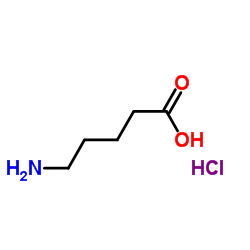5-氨基戊酸盐酸盐

5-氨基戊酸盐酸盐结构式

|
常用名 | 5-氨基戊酸盐酸盐 | 英文名 | 4-carboxybutan-1-aminium chloride |
|---|---|---|---|---|
| CAS号 | 627-95-2 | 分子量 | 153.607 | |
| 密度 | N/A | 沸点 | 247.5ºC at 760 mmHg | |
| 分子式 | C5H12ClNO2 | 熔点 | 95-97 °C(lit.) | |
| MSDS | 美版 | 闪点 | 103.5ºC |
|
Solid-state NMR analyses reveal the structure dependence of the molecular dynamics for ω-amino acids.
J. Phys. Chem. B 116(7) , 2096-103, (2012) The molecular dynamics of metabolites is structure dependent and vitally important for the interactive functions in their potential applications as natural materials. To understand the relationship between molecular structure and dynamics, the molecular motio... |
|
|
Metabolic engineering of Escherichia coli for the production of 5-aminovalerate and glutarate as C5 platform chemicals.
Metab. Eng. 16 , 42-7, (2013) 5-Aminovalerate (5AVA) is the precursor of valerolactam, a potential building block for producing nylon 5, and is a C5 platform chemical for synthesizing 5-hydroxyvalerate, glutarate, and 1,5-pentanediol. Escherichia coli was metabolically engineered for the ... |
|
|
Heterologous expression, purification, and characterization of an l-ornithine N(5)-hydroxylase involved in pyoverdine siderophore biosynthesis in Pseudomonas aeruginosa.
J. Bacteriol. 188(20) , 7205-10, (2006) Pseudomonas aeruginosa is an opportunistic pathogen that produces the siderophore pyoverdine, which enables it to acquire the essential nutrient iron from its host. Formation of the iron-chelating hydroxamate functional group in pyoverdine requires the enzyme... |
|
|
Transient state kinetic investigation of 5-aminolevulinate synthase reaction mechanism.
J. Biol. Chem. 277(47) , 44660-9, (2002) 5-Aminolevulinate synthase (ALAS), a pyridoxal 5'-phosphate-dependent enzyme, catalyzes the first, and regulatory, step of the heme biosynthetic pathway in nonplant eukaryotes and some bacteria. 5-Aminolevulinate synthase is a dimeric protein having an ordere... |
|
|
Evaluation of collagen alteration after topical photodynamic therapy (PDT) using second harmonic generation (SHG) microscopy--in vivo study in a mouse model.
Photodiagnosis Photodyn. Ther. 9(2) , 164-9, (2012) Topical photodynamic therapy (PDT) mediated by 5-aminolevulinic acid (ALA) has been used for the treatment of age-related skin lesions for therapeutic or cosmetic purposes. The modulation of collagen component and structure might play a significant role in in... |
|
|
Role of gamma-aminobutyricacidB(GABA(B)) receptors in the regulation of kainic acid-induced cell death in mouse hippocampus.
Exp. Mol. Med. 37(6) , 533-45, (2005) Kainic acid (KA) is well-known as an excitatory, neurotoxic substance. In mice, KA administered intracerebroventricularly (i.c.v.) lead to morphological damage of hippocampus expecially concentrated on the CA3 pyramidal neurons. In the present study, the poss... |
|
|
New chemotactic dimeric peptides show high affinity and potency at the human formylpeptide receptor.
Eur. J. Pharmacol. 567(1-2) , 171-6, (2007) A number of analogues of the prototypical peptide for-Met-Leu-Phe-OMe (fMLP-OMe) have been studied in order to evaluate their ability to interact with formylpeptide receptors and to induce specific biological responses in human neutrophils. In vitro assays we... |
|
|
Synthesis and structural study of cyclic 5-aminovaleric acid-linked beta-Ala-beta-Ala dipeptides.
Bioorg. Med. Chem. Lett. 18(22) , 5975-7, (2008) 5-Aminovaleric acid and ornithine were evaluated as linkers for the cyclization of beta-dipeptides. Two linked examples of beta-Ala-beta-Ala were prepared by standard coupling methods and their conformations probed by NMR, CD, and computational means. The dat... |
|
|
Indirect presynaptic modulation of striatal dopamine release by GABA(B) receptors in the rat substantia nigra.
Neurosci. Lett. 325(1) , 33-6, (2002) Regulation of striatal dopamine release by gamma-aminobutyric acid (GABA) neurotransmission was investigated using voltammetry in freely moving rats, following focal injection of the GABA(B) receptor agonist baclofen or the GABA(B) receptor antagonist 5-amino... |
|
|
[Dissociated learning with GABAergic drugs].
Zh. Vyssh. Nerv. Deiat. Im. I P Pavlova 58(1) , 63-70, (2008) The possibility of dissociated learning was investigated using drugs which act directly on GABAB receptors of the brain. The earlier proposed suggestion that the cholinergic system plays a key role in the mechanisms of dissociated learning was tested. It was ... |